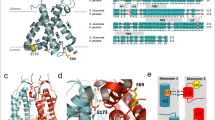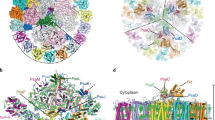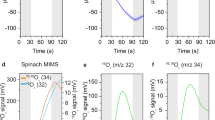Abstract
Photosystem I (PSI) uses light energy and electrons supplied by photosystem II (PSII) to reduce NADP+ to NADPH. PSI is very tolerant of excess light but extremely sensitive to excess electrons from PSII. It has been assumed that PSI is protected from photoinhibition by strict control of the intersystem electron transfer chain (ETC). Here we demonstrate that the iron–sulphur (FeS) clusters of PSI are more sensitive to high light stress than previously anticipated, but PSI with damaged FeS clusters still functions as a non-photochemical photoprotective energy quencher (PSI-NPQ). Upon photoinhibition of PSI, the highly reduced ETC further triggers thylakoid phosphorylation-based mechanisms that increase energy flow towards PSI. It is concluded that the sensitivity of FeS clusters provides an additional photoprotective mechanism that is able to downregulate PSII, based on PSI quenching and protein phosphorylation.
This is a preview of subscription content, access via your institution
Access options
Subscribe to this journal
Receive 12 digital issues and online access to articles
$119.00 per year
only $9.92 per issue
Buy this article
- Purchase on Springer Link
- Instant access to full article PDF
Prices may be subject to local taxes which are calculated during checkout






Similar content being viewed by others
References
Sonoike, K. Photoinhibition of photosystem I. Physiol. Plant. 142, 56–64 (2011).
Sonoike, K. & Terashima, I. Mechanism of photosystem-I photoinhibition in leaves of Cucumis sativus L. Planta 194, 287–293 (1994).
Tjus, S. E., Moller, B. L. & Scheller, H. V. Photosystem I is an early target of photoinhibition in barley illuminated at chilling temperatures. Plant Physiol. 116, 755–764 (1998).
Sonoike, K., Terashima, I., Iwaki, M. & Itoh, S. Destruction of photosystem I iron-sulfur centers in leaves of Cucumis sativus L. by weak illumination at chilling temperatures. FEBS Lett. 362, 235–238 (1995).
Suorsa, M. et al. PROTON GRADIENT REGULATION5 is essential for proper acclimation of Arabidopsis photosystem I to naturally and artificially fluctuating light conditions. Plant Cell 24, 2934–2948 (2012).
Kono, M., Noguchi, K. & Terashima, I. Roles of the cyclic electron flow around PSI (CEF-PSI) and O(2)-dependent alternative pathways in regulation of the photosynthetic electron flow in short-term fluctuating light in Arabidopsis thaliana. Plant Cell Physiol. 55, 990–1004 (2014).
Allahverdiyeva, Y., Suorsa, M., Tikkanen, M. & Aro, E. M. Photoprotection of photosystems in fluctuating light intensities. J. Exp. Bot. 66, 2427–2436 (2015).
Suorsa, M. et al. PGR5 ensures photosynthetic control to safeguard photosystem I under fluctuating light conditions. Plant. Signal. Behav. 8, e22741 (2013).
Tikkanen, M., Grieco, M., Kangasjarvi, S. & Aro, E. M. Thylakoid protein phosphorylation in higher plant chloroplasts optimizes electron transfer under fluctuating light. Plant Physiol. 152, 723–735 (2010).
Tikkanen, M., Mekala, N. R. & Aro, E. M. Photosystem II photoinhibition-repair cycle protects Photosystem I from irreversible damage. Biochim. Biophys. Acta 1837, 210–215 (2014).
Munekage, Y. et al. PGR5 is involved in cyclic electron flow around photosystem I and is essential for photoprotection in Arabidopsis. Cell 110, 361–371 (2002).
Shikanai, T., Munekage, Y., Shimizu, K., Endo, T. & Hashimoto, T. Identification and characterization of Arabidopsis mutants with reduced quenching of chlorophyll fluorescence. Plant Cell Physiol. 40, 1134–1142 (1999).
Munekage, Y. N., Genty, B. & Peltier, G. Effect of PGR5 impairment on photosynthesis and growth in Arabidopsis thaliana. Plant Cell Physiol. 49, 1688–1698 (2008).
Munekage, Y. et al. Cyclic electron flow around photosystem I is essential for photosynthesis. Nature 429, 579–582 (2004).
Suorsa, M. et al. PGR5-PGRL1-dependent cyclic electron transport modulates linear electron transport rate in Arabidopsis thaliana. Mol. Plant. 9, 271–288 (2015).
Danielsson, R., Albertsson, P. A., Mamedov, F. & Styring, S. Quantification of photosystem I and II in different parts of the thylakoid membrane from spinach. Biochim. Biophys. Acta 1608, 53–61 (2004).
Vassiliev, I. R., Antonkine, M. L. & Golbeck, J. H. Iron–sulfur clusters in type I reaction centers. Biochim. Biophys. Acta 1507, 139–160 (2001).
Li, N. et al. PsaD is required for the stable binding of PsaC to the photosystem I core protein of Synechococcus sp. PCC 6301. Biochemistry 30, 7863–7872 (1991).
Tikkanen, M. et al. Phosphorylation-dependent regulation of excitation energy distribution between the two photosystems in higher plants. Biochim. Biophys. Acta Bioenergetics 1777, 425–432 (2008).
Grieco, M., Suorsa, M., Jajoo, A., Tikkanen, M. & Aro, E. M. Light-harvesting II antenna trimers connect energetically the entire photosynthetic machinery - including both photosystems II and I. Biochim. Biophys. Acta 1847, 607–619 (2015).
Mekala, N. R., Suorsa, M., Rantala, M., Aro, E. M. & Tikkanen, M. Plants actively avoid state transitions upon changes in light intensity: role of light-harvesting complex II protein dephosphorylation in high light. Plant Physiol. 168, 721–734 (2015).
Benson, S. L. et al. An intact light harvesting complex I antenna system is required for complete state transitions in Arabidopsis. Nature Plants 1, 15176 (2015).
Yokono, M., Takabayashi, A., Akimoto, S. & Tanaka, A. A megacomplex composed of both photosystem reaction centres in higher plants. Nature Commun. 6, 6675 (2015).
Rintamaki, E., Martinsuo, P., Pursiheimo, S. & Aro, E. M. Cooperative regulation of light-harvesting complex II phosphorylation via the plastoquinol and ferredoxin-thioredoxin system in chloroplasts. Proc. Natl Acad. Sci. USA 97, 11644–11649 (2000).
Bonardi, V. et al. Photosystem II core phosphorylation and photosynthetic acclimation require two different protein kinases. Nature 437, 1179–1182 (2005).
Vainonen, J. P., Hansson, M. & Vener, A. V. STN8 protein kinase in Arabidopsis thaliana is specific in phosphorylation of photosystem II core proteins. J. Biol. Chem. 280, 33679–33686 (2005).
Lunde, C., Jensen, P. E., Haldrup, A., Knoetzel, J. & Scheller, H. V. The PSI-H subunit of photosystem I is essential for state transitions in plant photosynthesis. Nature 408, 613–615 (2000).
Andreeva, A., Stoitchkova, K., Busheva, M. & Apostolova, E. Changes in the energy distribution between chlorophyll-protein complexes of thylakoid membranes from pea mutants with modified pigment content. I. Changes due to the modified pigment content . J. Photochem. Photobiol. B. 70, 153–162 (2003).
van der Lee, J. et al. Steady-state polarized light spectroscopy of isolated Photosystem I complexes. Photosynth Res. 35, 311–321 (1993).
Choi, S. M. et al. Chloroplast Cu/Zn-superoxide dismutase is a highly sensitive site in cucumber leaves chilled in the light. Planta 216, 315–324 (2002).
Warden, J. T. & Golbeck, J. H. Photosystem I charge separation in the absence of centers A and B. II. ESR spectral characterization of center ‘X’ and correlation with optical signal ‘A2’. Biochim. Biophys. Acta Bioenergetics 849, 25–31 (1986).
Rutherford, A. W., Osyczka, A. & Rappaport, F. Back-reactions, short-circuits, leaks and other energy wasteful reactions in biological electron transfer: redox tuning to survive life in O2. FEBS Lett. 586, 603–616 (2012).
Schlodder, E., Cetin, M., Byrdin, M., Terekhova, I. V. & Karapetyan, N. V. P700+− and 3P700-induced quenching of the fluorescence at 760 nm in trimeric Photosystem I complexes from the cyanobacterium Arthrospira platensis. Biochim. Biophys. Acta 1706, 53–67 (2005).
Bellafiore, S., Barneche, F., Peltier, G. & Rochaix, J. D. State transitions and light adaptation require chloroplast thylakoid protein kinase STN7. Nature 433, 892–895 (2005).
Tikkanen, M. et al. Regulation of the photosynthetic apparatus under fluctuating growth light. Philos. Trans. R. Soc. Lond. B. Biol. Sci. 367, 3486–3493 (2012).
Acknowledgements
Research was financially supported by the Academy of Finland Center of Excellence project (271832), a post-doctoral research grant to M.T. (260094) and an Academy Professor research grant to E.-M.A. (273870). S.S. and F.M. thankfully acknowledge the Swedish Research Council, the Swedish Energy Agency and the Knut and Alice Wallenberg Foundation. The PsaD antibody is a kind gift from H. Vibe Scheller, and the pgr5 mutant and the gl1 wild-type control were kindly provided by T. Shikanai.
Author information
Authors and Affiliations
Contributions
A.T., M.T., M.S., A.J. and E.-M.A. designed the study; A.T. and F.M. performed the research; A.T., F.M. and M.G. contributed analytical tools; A.T., M.T., S.S., F.M. and E.-M.A. analysed the data; A.T., F.M., M.T., M.S. and E.-M.A. wrote the paper.
Corresponding authors
Ethics declarations
Competing interests
The authors declare no competing financial interests.
Supplementary information
Rights and permissions
About this article
Cite this article
Tiwari, A., Mamedov, F., Grieco, M. et al. Photodamage of iron–sulphur clusters in photosystem I induces non-photochemical energy dissipation. Nature Plants 2, 16035 (2016). https://doi.org/10.1038/nplants.2016.35
Received:
Accepted:
Published:
DOI: https://doi.org/10.1038/nplants.2016.35
This article is cited by
-
Flavodiiron-mediated O2 photoreduction at photosystem I acceptor-side provides photoprotection to conifer thylakoids in early spring
Nature Communications (2023)
-
Honoring two stalwarts of photosynthesis research: Eva-Mari Aro and Govindjee
Photosynthesis Research (2023)
-
Recent advances in the understanding of superoxide anion radical formation in the photosynthetic electron transport chain
Acta Physiologiae Plantarum (2022)
-
Multi-element Interactive Improvement Mechanism of Coal Fly Ash-Based Soil Conditioner on Wheat
Applied Biochemistry and Biotechnology (2022)
-
A Critical Review on Iron-Enhanced Constructed Wetland System: Mechanisms and Application Scope
Water, Air, & Soil Pollution (2022)



